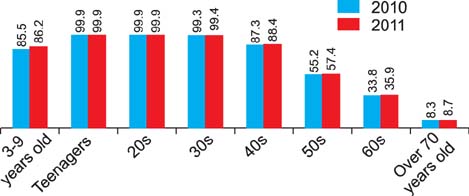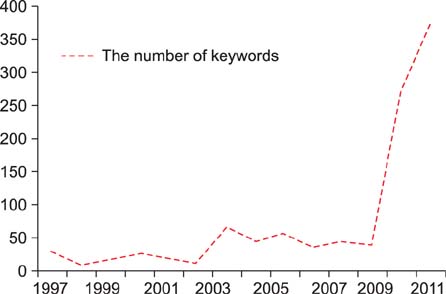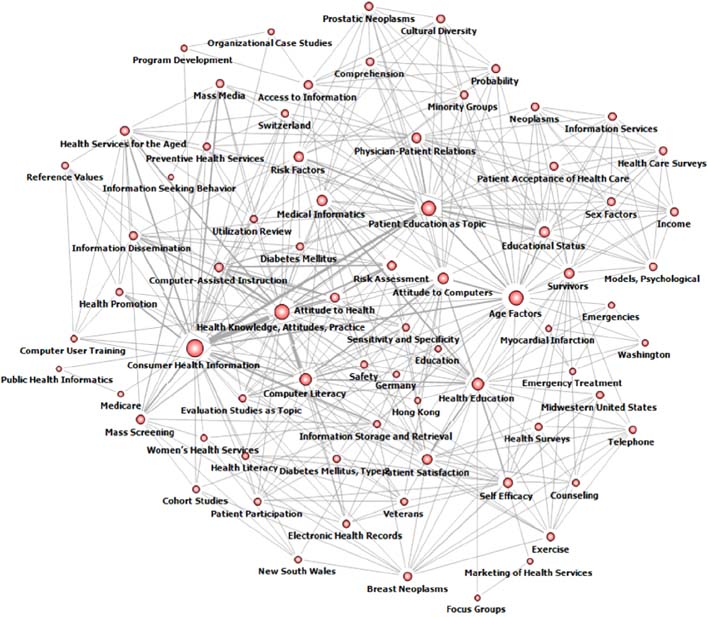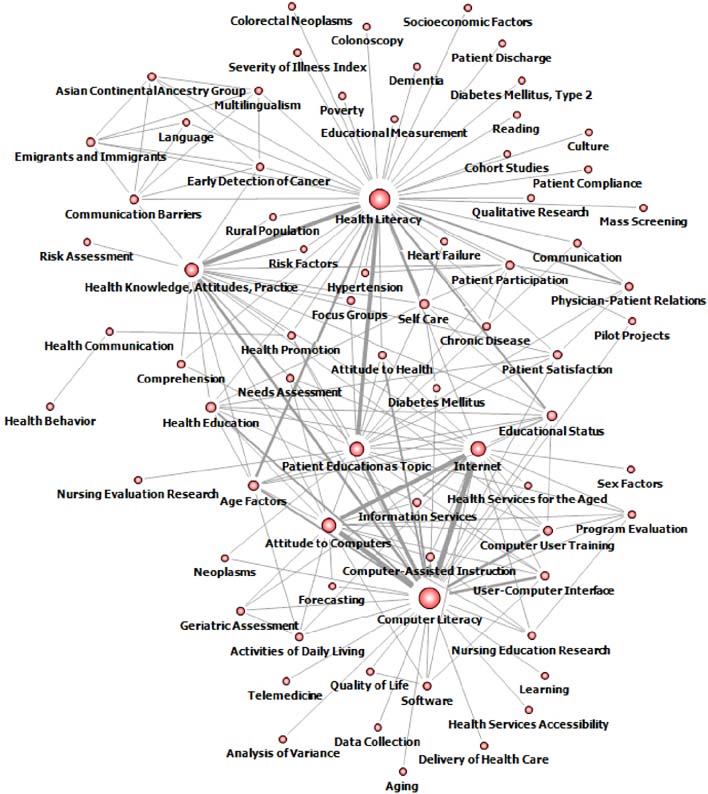Healthc Inform Res.
2014 Jul;20(3):216-225. 10.4258/hir.2014.20.3.216.
Social Network Analysis of Elders' Health Literacy and their Use of Online Health Information
- Affiliations
-
- 1Herbal and Health Management, Joongbu University, Geumsan, Korea.
- 2u-Healthcare Design & Healthcare Service Design Development Program, Design Institute, Inje University, Seoul, Korea. ajy0130@inje.ac.kr
- KMID: 2284585
- DOI: http://doi.org/10.4258/hir.2014.20.3.216
Abstract
OBJECTIVES
Utilizing social network analysis, this study aimed to analyze the main keywords in the literature regarding the health literacy of and the use of online health information by aged persons over 65.
METHODS
Medical Subject Heading keywords were extracted from articles on the PubMed database of the National Library of Medicine. For health literacy, 110 articles out of 361 were initially extracted. Seventy-one keywords out of 1,021 were finally selected after removing repeated keywords and applying pruning. Regarding the use of online health information, 19 articles out of 26 were selected. One hundred forty-four keywords were initially extracted. After removing the repeated keywords, 74 keywords were finally selected.
RESULTS
Health literacy was found to be strongly connected with 'Health knowledge, attitudes, practices' and 'Patient education as topic.' 'Computer literacy' had strong connections with 'Internet' and 'Attitude towards computers.' 'Computer literacy' was connected to 'Health literacy,' and was studied according to the parameters 'Attitude towards health' and 'Patient education as topic.' The use of online health information was strongly connected with 'Health knowledge, attitudes, practices,' 'Consumer health information,' 'Patient education as topic,' etc. In the network, 'Computer literacy' was connected with 'Health education,' 'Patient satisfaction,' 'Self-efficacy,' 'Attitude to computer,' etc.
CONCLUSIONS
Research on older citizens' health literacy and their use of online health information was conducted together with study of computer literacy, patient education, attitude towards health, health education, patient satisfaction, etc. In particular, self-efficacy was noted as an important keyword. Further research should be conducted to identify the effective outcomes of self-efficacy in the area of interest.
MeSH Terms
Figure
Reference
-
1. Statistics Korea. 2010 National social statistics survey. Deajeon, Korea: Statistics Korea;2010.2. Kiel JM. The digital divide: Internet and e-mail use by the elderly. Med Inform Internet Med. 2005; 30(1):19–23.
Article3. Kuttan A, Peters L. From digital divide to digital opportunity. Lanham (MD): Scarecrow Press;2003.4. An JY. Correlates and predictors of consumers' health information and services usage behavior on the Internet: a structural equation modeling approach [dissertation]. New York (NY): New York University;2005.5. National Information Society Agency. 2007 Digital divide index and status report. Seoul, Korea: National Information Society Agency;2008.6. National Information Society Agency. 2009 A study on the digital divide of the Korean older adults. Seoul, Korea: National Information Society Agency;2010.7. National Information Society Agency. 2010 Digital divide index and status report. Seoul, Korea: National Information Society Agency;2010.8. An JY. Theory development in health care informatics: information and communication technology acceptance model (ICTAM) improves the explanatory and predictive power of technology acceptance models. Stud Health Technol Inform. 2006; 122:63–67.9. An JY, Hayman LL, Panniers T, Carty B. Theory development in nursing and healthcare informatics: a model explaining and predicting information and communication technology acceptance by healthcare consumers. ANS Adv Nurs Sci. 2007; 30(3):E37–E49.10. Song T, Um K, An JY. The development of an evaluation model for the acceptability of health information websites. J Korean Soc Med Inform. 2005; 11(3):221–233.
Article11. Furlong MS. An electronic community for older adults: the SeniorNet Network. J Commun. 1989; 39(3):145–153.
Article12. Korea Internet Security Agency. 2011 Internet usage survey. Seoul, Korea: Korea Internet Security Agency;2011.13. Lee GY. An exploratory study on the effects of Internet use on the adaptation process in later life. J Welf Aged. 2007; 37:7–30.14. Eriksson-Backa K, Ek S, Niemela R, Huotari ML. Health information literacy in everyday life: a study of Finns aged 65-79 years. Health Informatics J. 2012; 18(2):83–94.
Article15. Campbell RJ, Nolfi DA. Teaching elderly adults to use the Internet to access health care information: before-after study. J Med Internet Res. 2005; 7(2):e19.
Article16. Chen C. Searching for intellectual turning points: progressive knowledge domain visualization. Proc Natl Acad Sci U S A. 2004; 101:Suppl 1. 5303–5310.
Article17. Mane KK, Borner K. Mapping topics and topic bursts in PNAS. Proc Natl Acad Sci U S A. 2004; 101:Suppl 1. 5287–5290.
Article18. Sohn DW. Social network analysis. 4th ed. Seoul, Korea: Kyungmun Publisher;2010.19. He Q. Knowledge discovery through co-word analysis. Libr Trends. 1999; 48(1):133–159.20. Polanco X. Co-word analysis revisited: Modeling co-word cluster in terms of graph theory. In : Proceeding of the 10th International Conference of the International Society for Scientometrics and Informetrics; 2005 Jul 24-28; Stockholm, Sweden. p. 662–663.21. Zhang J, Xie J, Hou W, Tu X, Xu J, Song F, et al. Mapping the knowledge structure of research on patient adherence: knowledge domain visualization based co-word analysis and social network analysis. PLoS One. 2012; 7(4):e34497.
Article22. Jang HL, Lee YS, An JY. Application of social network analysis to health care sectors. Healthc Inform Res. 2012; 18(1):44–56.
Article23. Jung M, Chung D. Co-author and keyword networks and their clustering appearance in preventive medicine fields in Korea: analysis of papers in the Journal of Preventive Medicine and Public Health, 1991-2006. J Prev Med Public Health. 2008; 41(1):1–9.
Article24. Jung M. Academic research activities and their co-author and keyword network in epidemiology fields: analysis of papers in the Korean Journal of Epidemiology, 1991-2006. Korean J Epidemiol. 2008; 30(1):60–72.
Article25. Jeong S, Lee SK, Kim HG. Knowledge structure of korean medical informatics: a social network analysis of articles in journal and proceedings. Healthc Inform Res. 2010; 16(1):52–59.
Article26. Lee SK, Jeong S, Kim HG, Yom YH. A social network analysis of research topics in Korean nursing science. J Korean Acad Nurs. 2011; 41(5):623–632.
Article27. Lee YS. Research network analysis for the national science knowledge map. Seoul, Korea: Korea Research Council of Fundamental Science and Technology;2010.28. Sohn DK. Generation and analysis of the research network for colorectal neoplasms [dissertation]. Cheongju, Korea: Chungbuk National University;2011.29. Kim YH. Social network analysis. 2nd ed. Seoul, Korea: Pakyoungsa;2007.30. Faust K. Comparing social networks: size, density, and local structure. Metodoloski zvezki. 2006; 3(2):185–216.31. Bogatti SP. Centrality and network flow. Soc Networks. 2005; 27(1):55–71.
Article32. Adamic LA, Lukose RM, Puniyani AR, Huberman BA. Search in power-law networks. Phys Rev E Stat Nonlin Soft Matter Phys. 2001; 64(4 Pt 2):046135.
Article33. Callon M, Coutial JP, Laville F. Co-word analysis as a tool for describing the network of interactions between basic and technological research: the case of polymer chemistry. Scientometrics. 1991; 22(1):153–205.34. Wang X, Wang J, Ma F, Hu C. The "small-world" characteristic of author co-words network. In : Proceedings of the International Conference on Wireless Communications, Networking and Mobile Computing; 2007 Sep 21-25; Shanghai, China. p. 3717–3720.35. Lee JY. Centrality measure for bibliometric network analysis. J Korean Libr Inf Sci Soc. 2006; 40(3):191–214.36. Boyack KW, Klavans R. Co-citation analysis, bibliographic coupling, and direct citation: which citation approach represents the research front most accurately? J Am Soc Inf Sci Technol. 2010; 61(12):2389–2404.
Article37. Yeo WD, Sohn ES, Jung ES, Lee CH. Identification of emerging research at the national level: scientific approach using Scopus. J Inf Manag. 2008; 39(3):95–113.
Article38. Huh S. Medical databases from Korea and abroad. J Korean Med Assoc. 2010; 53(8):659–667.
Article39. Kim SY. From MeSH indexed to retrieval. 1st ed. Seoul, Korea: Korean Medical Library Association;2008.40. Kwon AK, Chae YM. The study on subject words of Korean medical informatics by expanded MeSH: based on journal of the Korean society of medical informatics. J Korean Soc Med Inform. 2002; 8(4):91–98.
Article41. Stagmann J, Grohmann G. Hypothesis generation guided by co-word clustering. Scientometrics. 2003; 56(1):111–135.42. An XY, Wu QQ. Co-word analysis of the trends in stem cells field based on subject heading weighting. Scientometrics. 2011; 88(1):133–144.
Article43. Osphal T, Agneessens F, Skvoretz J. Node centrality in weighted networks: generalizing degree and shortest paths. Soc Networks. 2010; 32(3):245–251.
Article44. Zheng HC, Yan L, Cui L, Guan YF, Takano Y. Mapping the history and current situation of research on John Cunningham virus: a bibliometric analysis. BMC Infect Dis. 2009; 9:28.
- Full Text Links
- Actions
-
Cited
- CITED
-
- Close
- Share
- Similar articles
-
- A Study on Related Factors Use of Health Information and Health Literacy Among the Vulnerable Elderly in Community
- Health Literacy, Health Risk Perception and Health Behavior of Elders
- Correlation of Social Network Types on Health Status of Korean Elders
- The Impact of Mothers’ Smartphone Use, eHealth Literacy, Maternal Role Performance Confidence, and Online Social Support on Health Promotion Behavior for Infants and Toddlers
- Health Literacy and Health Status of Korean-Chinese Elderly People Living in Yanbian, China





